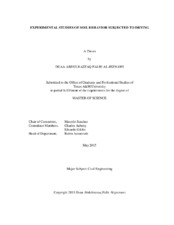| dc.description.abstract | Expansive soils (also known as shrink/swell soils) are encountered in different regions of the world. The behavior of this type of soils is quiet complex. They fall in the category of ‘problematic soils’. One a typical characteristics of this material is the formation of cracks during drying and shrinkage. The presence of cracks in soils is very detrimental as its affects the hydraulic behavior (e.g. providing pathways for water flow and pollutant transport) and the mechanical behavior (e.g. impacting on soil strength and other mechanical properties). As a consequence, the presence of cracks in soils may, amongst other: trigger landslides, increase the infiltration capacity of soils, and induce differential settlement in buildings. One of the aims of this thesis is to improve our current understanding on crack formation and propagation. Soil curling is another phenomenon associated with soil drying. The goal of this study is to enhance the understanding of the behavior of soils under drying conditions. This would expand our capabilities in dealing with a wide spectrum of geotechnical and geologic problems related to the modeling of shrink-swell soils.
The literature review performed in this thesis detected significant gaps in the knowledge regarding factors and parameters that control the development and propagation of desiccation cracks in soils and also curling deformation in soils. In this research, these phenomena associated with soil drying were studied through laboratory experiments using different mixtures of artificial soils.
This thesis includes experimental and theoretical investigations of drying soil under different conditions. For this purpose, a total of thirteen tests related to cracking and shrinking were carried out; considering: i) different soil mixtures; ii) different environmental conditions at controlled relative humidity (i.e. testing at the lab atmosphere versus testing inside a desiccator under controlled relative humidity conditions); iii) different roughness of the soil-plate interface (i.e. rough versus smooth surfaces); and iv) different water salinity (i.e. distilled water versus saturated salt solutions). Additionally, the effect of wetting and drying cycles on soil cracking pattern was also investigated. The results of these tests were analyzed based on both visual inspection and via image analysis techniques (using the image j software). This technique facilitates the process of determining the location and severity of cracked areas and it also provides useful information to determine the width, length, and shape of the cracks.
The soil shear parameters (i.e. cohesion and friction angle) and the soil-interface strength parameters (i.e. soil-interface adhesion and interface friction angle) for the kaolinite/ bentonite mixture were obtained from the direct shear test. A total of fifty tests were carried out while varying the drainage conditions (i.e. drained or undrained conditions), soil water content, soil-plate contact surface (i.e. smooth or rough), and the normal load. Since curling phenomenon was visually observed in some samples, a set of additional eleven drying tests were carried out to study in more detail this feature of soil behavior.
The effect of two main factors influencing soil curling was investigated: soil mixture (i.e. percentage of different soils) and initial water content.
The results show that the contact surface has a significant effect on soil behavior during drying. In particular, cracked and uncracked areas, average width of cracks, and the crack intensity factor (CIF) were obtained to determine the development of crack patterns. In general, these parameters are critical when modeling the formation and propagation of cracks. Furthermore, experimental results showed that the maximum shearing resistance is controlled by the drainage conditions, the roughness of the interface material, the water content of the soil, and the normal stress. For a specific soil mixture, the maximum interface shear stress (i.e. maximum shear stress of the soil-grooved plate interface) was observed just before the initiation of the desiccation cracks. Moreover, soil fabric and soil water content have significant effects on soil behavior during drying. It has been observed that particles sizes distribution has a significant effect of soil curling deformation. It was concluded that the particle size distribution of soil samples prepared at high water content (e.g. 2.75× LL and 3× LL; where LL is the soil's liquid limit) is governed by sedimentation phenomenon at early stages of drying. | en |


